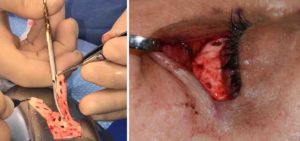Undereye hollows are a bothersome aesthetic deformity. They occur for a variety of reasons with the cost common being aging with loss of fat and a congenital infraorbital bone deficiency with a negative orbital vector. This creates for the patient a look of aging and tiredness and even a pseudoproptotic appearance.
The most common treatment for undereye hollows are synthetic injectable fillers. A wide variety of filler types have been used but the hyaluronic acid-based fillers are associated with the least undesirable aesthetic issues. But issues with lumps and bumps and unevenness remain as the thin lower eyelid skin is very unforgiving. Fat injections are also commonly used for treatment but they have the same potential contour issues and their survival is far from assured.
When a lower blepharoplasty is needed the opportunity arises for a grafting approach to the undereye hollows. Fat transposition of lower eyelid fat is often done but may not be adequate if the hollowing effect is more than just isolated to that of the tear troughs. More graft volume may be needed than that of what the orbital fat compartments can provide.

One question is the long-term stability of such dermal grafts to the lower eyelid. My experience with thicker Alloderm grafts in the face in general is that they remain stable without long-term resorption.
Dr. Barry Eppley
Indianapolis Indiana


